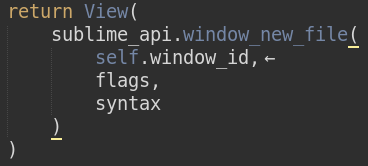AutoSplit
Autosplit plugin for Sublime
Details
Installs
- Total 541
- Win 315
- Mac 133
- Linux 93
| Dec 20 | Dec 19 | Dec 18 | Dec 17 | Dec 16 | Dec 15 | Dec 14 | Dec 13 | Dec 12 | Dec 11 | Dec 10 | Dec 9 | Dec 8 | Dec 7 | Dec 6 | Dec 5 | Dec 4 | Dec 3 | Dec 2 | Dec 1 | Nov 30 | Nov 29 | Nov 28 | Nov 27 | Nov 26 | Nov 25 | Nov 24 | Nov 23 | Nov 22 | Nov 21 | Nov 20 | Nov 19 | Nov 18 | Nov 17 | Nov 16 | Nov 15 | Nov 14 | Nov 13 | Nov 12 | Nov 11 | Nov 10 | Nov 9 | Nov 8 | Nov 7 | Nov 6 | |
|---|---|---|---|---|---|---|---|---|---|---|---|---|---|---|---|---|---|---|---|---|---|---|---|---|---|---|---|---|---|---|---|---|---|---|---|---|---|---|---|---|---|---|---|---|---|
| Windows | 0 | 0 | 0 | 0 | 0 | 0 | 0 | 0 | 1 | 0 | 1 | 0 | 0 | 0 | 0 | 0 | 0 | 1 | 1 | 0 | 0 | 0 | 0 | 0 | 0 | 0 | 0 | 0 | 0 | 0 | 1 | 0 | 0 | 0 | 1 | 0 | 0 | 0 | 0 | 1 | 0 | 0 | 0 | 0 | 1 |
| Mac | 0 | 0 | 0 | 0 | 0 | 0 | 0 | 0 | 0 | 0 | 0 | 0 | 0 | 0 | 0 | 1 | 0 | 0 | 0 | 0 | 0 | 0 | 0 | 0 | 0 | 0 | 0 | 0 | 0 | 0 | 0 | 0 | 0 | 0 | 0 | 0 | 0 | 0 | 0 | 1 | 0 | 0 | 0 | 0 | 0 |
| Linux | 0 | 0 | 0 | 0 | 0 | 0 | 0 | 0 | 0 | 0 | 0 | 0 | 0 | 0 | 0 | 0 | 0 | 0 | 0 | 0 | 0 | 0 | 0 | 0 | 0 | 0 | 0 | 0 | 0 | 0 | 0 | 0 | 0 | 0 | 0 | 0 | 0 | 0 | 0 | 0 | 0 | 0 | 0 | 1 | 0 |
Readme
- Source
- raw.githubusercontent.com
AutoSplit
AutoSplit is a Sublime Text 3 plugin for automatic splitting arguments across multiple lines and joining them back to one line. Works currently only for Python. Support for other languages is ahead.
AutoSplit assumes that function or method calls can be in 1 of 3 possible forms:
inline: all the arguments fit on the same line as the opening parenthesis
(view_id = sublime_api.window_find_open_file(self.window_id, fname)
next line: all the arguments are on the following line, closing parenthesis
)is on the 3rd lineview_id = sublime_api.window_find_open_file( self.window_id, fname )
multiline: every argument is on a fresh line:
view_id = sublime_api.window_find_open_file( self.window_id, fname )
Split/Join commands
AutoSplit provides for (semi-)automatic switching between these argument list forms. All of the command operate on the innermost arglist(s) the cursor(s) is(are) in.
Split (suggested keybinding:
Alt+])Push args off the first line (the line of the opening
() to the next line. If already at the next line, split them across multiple lines (every arg on its own line).Join (suggested keybinding:
Alt+[)Try to join all of the arguments to the next line. If all the arguments are already on the next line, then try to lift them up to the first line.

Split if too long
If you've got the ruler configured, AutoSplit will automatically split long argument lists (the ones that surpass the ruler).

Join indicators
Once you've deleted enough of the contents of the arglist so that it's possible to join it up again, there appears a (clickable) arrow indicator. The arrow is implemented as a Sublime phantom so it's not a part of your text. The arrow just says “it's possible to join the current arglist up”.


An up arrow says “possible to join to the first line”, a left arrow says “possible to join to the next line”.
You can turn on/off arrow indication with the setting named show_arrows.
Multiline tails
The last nested argument list can actually span multiple lines, whereas an initial part of it still resides at the same line as the parent's opening parenthesis:
def new_file(self, flags=0, syntax=""):
""" flags must be either 0 or TRANSIENT """
return View(sublime_api.window_new_file(self.window_id, flags, get_syntax(
nested_call_1(arg1),
nested_call_2(arg2),
nested_call_3(arg3)
)))
We refer to such argument lists as “multiline tails” of their parents. In this example, get_syntax is a multiline tail of window_new_file call. AutoSplit has special support for multiline tails:
splitting an arglist with a multiline tail correctly adjusts indentation inside the tail
def new_file(self, flags=0, syntax=""): """ flags must be either 0 or TRANSIENT """ return View( sublime_api.window_new_file( self.window_id, flags, get_syntax( nested_call_1(arg1), nested_call_2(arg2), nested_call_3(arg3) ) ) )
Accordingly, joining an arglist with a multiline tail dedents the tail back.
if it's only possible to join an arglist with a multiline tail, this is indicated with dashed up and left arrows:

In this example, it's not possible to fully join the arglist up to one line. But it's possible to join it partially, that is, leaving the multiline tail unjoined. Thich is indicated by the dashed arrows.
Keybindings
The 2 commands autosplit_split and autosplit_join is best to use with keybindings, such as Alt+[ or Alt+] or any other you like. For suggested key bindings, please choose the Preferences -> AutoSplit -> Example Key Bindings menu.
